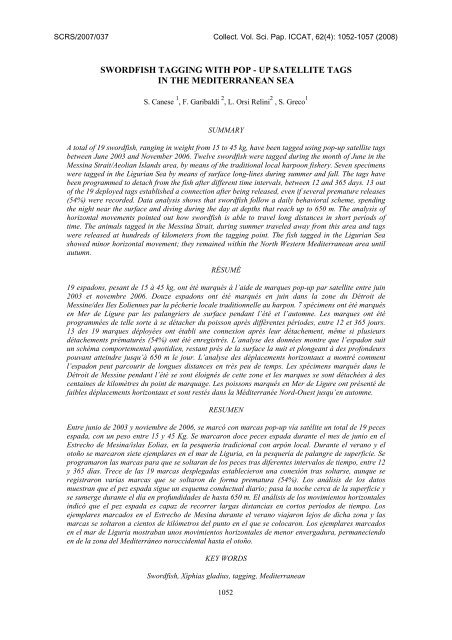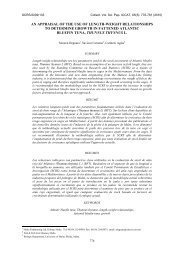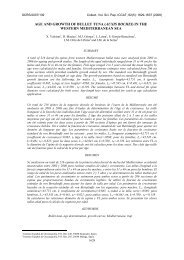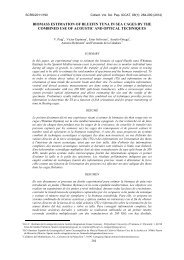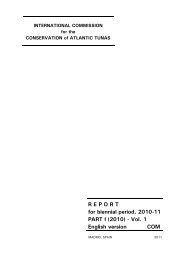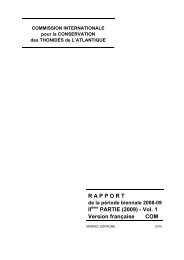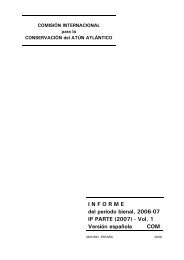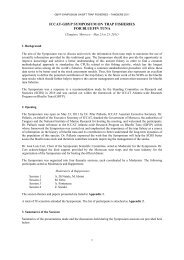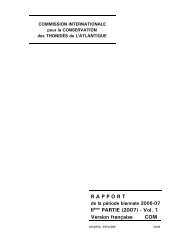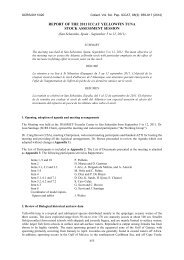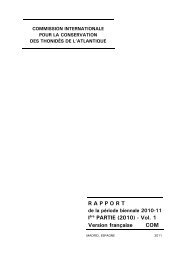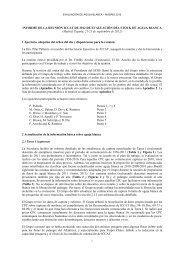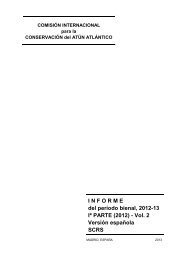swordfish tagging with pop - up satellite tags in the ... - Iccat
swordfish tagging with pop - up satellite tags in the ... - Iccat
swordfish tagging with pop - up satellite tags in the ... - Iccat
- No tags were found...
Create successful ePaper yourself
Turn your PDF publications into a flip-book with our unique Google optimized e-Paper software.
SCRS/2007/037 Collect. Vol. Sci. Pap. ICCAT, 62(4): 1052-1057 (2008)SWORDFISH TAGGING WITH POP - UP SATELLITE TAGSIN THE MEDITERRANEAN SEAS. Canese 1 , F. Garibaldi 2 , L. Orsi Rel<strong>in</strong>i 2 , S. Greco 1SUMMARYA total of 19 <strong>swordfish</strong>, rang<strong>in</strong>g <strong>in</strong> weight from 15 to 45 kg, have been tagged us<strong>in</strong>g <strong>pop</strong>-<strong>up</strong> <strong>satellite</strong> <strong>tags</strong>between June 2003 and November 2006. Twelve <strong>swordfish</strong> were tagged dur<strong>in</strong>g <strong>the</strong> month of June <strong>in</strong> <strong>the</strong>Mess<strong>in</strong>a Strait/Aeolian Islands area, by means of <strong>the</strong> traditional local harpoon fishery. Seven specimenswere tagged <strong>in</strong> <strong>the</strong> Ligurian Sea by means of surface long-l<strong>in</strong>es dur<strong>in</strong>g summer and fall. The <strong>tags</strong> havebeen programmed to detach from <strong>the</strong> fish after different time <strong>in</strong>tervals, between 12 and 365 days. 13 outof <strong>the</strong> 19 deployed <strong>tags</strong> established a connection after be<strong>in</strong>g released, even if several premature releases(54%) were recorded. Data analysis shows that <strong>swordfish</strong> follow a daily behavioral scheme, spend<strong>in</strong>g<strong>the</strong> night near <strong>the</strong> surface and div<strong>in</strong>g dur<strong>in</strong>g <strong>the</strong> day at depths that reach <strong>up</strong> to 650 m. The analysis ofhorizontal movements po<strong>in</strong>ted out how <strong>swordfish</strong> is able to travel long distances <strong>in</strong> short periods oftime. The animals tagged <strong>in</strong> <strong>the</strong> Mess<strong>in</strong>a Strait, dur<strong>in</strong>g summer traveled away from this area and <strong>tags</strong>were released at hundreds of kilometers from <strong>the</strong> <strong>tagg<strong>in</strong>g</strong> po<strong>in</strong>t. The fish tagged <strong>in</strong> <strong>the</strong> Ligurian Seashowed m<strong>in</strong>or horizontal movement; <strong>the</strong>y rema<strong>in</strong>ed <strong>with</strong><strong>in</strong> <strong>the</strong> North Western Mediterranean area untilautumn.RÉSUMÉ19 espadons, pesant de 15 à 45 kg, ont été marqués à l’aide de marques <strong>pop</strong>-<strong>up</strong> par <strong>satellite</strong> entre ju<strong>in</strong>2003 et novembre 2006. Douze espadons ont été marqués en ju<strong>in</strong> dans la zone du Détroit deMess<strong>in</strong>e/des Iles Eoliennes par la pêcherie locale traditionnelle au harpon. 7 spécimens ont été marquésen Mer de Ligure par les palangriers de surface pendant l’été et l’automne. Les marques ont étéprogrammées de telle sorte à se détacher du poisson après différentes périodes, entre 12 et 365 jours.13 des 19 marques déployées ont établi une connexion après leur détachement, même si plusieursdétachements prématurés (54%) ont été enregistrés. L’analyse des données montre que l’espadon suitun schéma comportemental quotidien, restant près de la surface la nuit et plongeant à des profondeurspouvant atte<strong>in</strong>dre jusqu’à 650 m le jour. L’analyse des déplacements horizontaux a montré commentl’espadon peut parcourir de longues distances en très peu de temps. Les spécimens marqués dans leDétroit de Mess<strong>in</strong>e pendant l’été se sont éloignés de cette zone et les marques se sont détachées à descenta<strong>in</strong>es de kilomètres du po<strong>in</strong>t de marquage. Les poissons marqués en Mer de Ligure ont présenté defaibles déplacements horizontaux et sont restés dans la Méditerranée Nord-Ouest jusqu’en automne.RESUMENEntre junio de 2003 y noviembre de 2006, se marcó con marcas <strong>pop</strong>-<strong>up</strong> vía satélite un total de 19 pecesespada, con un peso entre 15 y 45 Kg. Se marcaron doce peces espada durante el mes de junio en elEstrecho de Mes<strong>in</strong>a/islas Eolias, en la pesquería tradicional con arpón local. Durante el verano y elotoño se marcaron siete ejemplares en el mar de Liguria, en la pesquería de palangre de s<strong>up</strong>erficie. Seprogramaron las marcas para que se soltaran de los peces tras diferentes <strong>in</strong>tervalos de tiempo, entre 12y 365 días. Trece de las 19 marcas desplegadas establecieron una conexión tras soltarse, aunque seregistraron varias marcas que se soltaron de forma prematura (54%). Los análisis de los datosmuestran que el pez espada sigue un esquema conductual diario; pasa la noche cerca de la s<strong>up</strong>erficie yse sumerge durante el día en profundidades de hasta 650 m. El análisis de los movimientos horizontales<strong>in</strong>dicó que el pez espada es capaz de recorrer largas distancias en cortos periodos de tiempo. Losejemplares marcados en el Estrecho de Mes<strong>in</strong>a durante el verano viajaron lejos de dicha zona y lasmarcas se soltaron a cientos de kilómetros del punto en el que se colocaron. Los ejemplares marcadosen el mar de Liguria mostraban unos movimientos horizontales de menor envergadura, permaneciendoen de la zona del Mediterráneo noroccidental hasta el otoño.KEY WORDSSwordfish, Xiphias gladius, <strong>tagg<strong>in</strong>g</strong>, Mediterranean1052
1. IntroductionSwordfish, Xiphias gladius, represents a worldwide important fishery resource, so that many studies were carriedout <strong>in</strong> <strong>the</strong> past about its general biology. In this way <strong>in</strong> <strong>the</strong> Mediterranean Sea <strong>in</strong>formation regard<strong>in</strong>greproduction (Cavallaro et al., 1991; Corriero et al., 2004; De La Serna et al., 1996; Orsi Rel<strong>in</strong>i et al, 1999,2003), age and growth (Megalofonou and De Metrio, 1989; Rollandi et al., 2005; Tserpes and Tsimenides,1995), food and feed<strong>in</strong>g habits (Orsi Rel<strong>in</strong>i et al., 1995; Peristeraki et al., 2005; Salman, 2004) genetic(Alvarado Bremer et al., 2005; Chow et al., 1997; Kotoulas et al., 1995, 1996; Magoulas et al., 1993; Pujolar etal., 2002) and pollutant (Fossi et al., 2001; Stefanelli P. et al., 2004) is extensive, as opposed to <strong>the</strong> scarcity of<strong>in</strong>formation regard<strong>in</strong>g its div<strong>in</strong>g behavior, habitat use and migrations, that are extremely rare at a worldwidelevel (Brill R. and Musyl M., 2003; Carey, 1990; Carey F.G. and Rob<strong>in</strong>son B.H., 1981; Sedberry G.R. andLoefer J.K. 2001; Takahashi et al., 2003) and quite totally miss<strong>in</strong>g for <strong>the</strong> Mediterranean Sea (Canese et al.,2004; Garibaldi et al., 2000). The present research project has been designed and developed <strong>in</strong> order to collectdata on <strong>swordfish</strong> div<strong>in</strong>g behavior and migrations through <strong>the</strong> use of <strong>pop</strong>-<strong>up</strong> archival <strong>satellite</strong> <strong>tags</strong>.2. Materials and methodsSwordfish were tagged us<strong>in</strong>g <strong>pop</strong>-<strong>up</strong> <strong>satellite</strong> <strong>tags</strong> <strong>in</strong> <strong>the</strong> framework of two different research programs, fundedby <strong>the</strong> M<strong>in</strong>istry of <strong>the</strong> Environment and M<strong>in</strong>istry of Agricultural Policies, cover<strong>in</strong>g 3 years, from 2003 to 2006.Two different <strong>pop</strong>-<strong>up</strong> <strong>tags</strong> were used: on <strong>the</strong> first year 4 Microwave Telemetry Ptt 100 <strong>tags</strong> (12 days <strong>in</strong> <strong>the</strong>Ligurian Sea, 365 days <strong>in</strong> <strong>the</strong> Mess<strong>in</strong>a Straits); all o<strong>the</strong>r <strong>tags</strong> were Wildlife Computers PAT4 and MK10 Tags.Tags were secured to <strong>the</strong> back of <strong>the</strong> animals, close to <strong>the</strong> first dorsal f<strong>in</strong>, us<strong>in</strong>g a te<strong>the</strong>r <strong>with</strong> a Floy Tag andsta<strong>in</strong>less steel darts. Data were transmitted by means of <strong>the</strong> Argos System.In order to achieve a widespread spatio-temporal distribution of fishes, specimens have been tagged <strong>in</strong> differentseasons and two different locations:a) Mess<strong>in</strong>a Strait / Eolian Islands area, by <strong>the</strong> means of <strong>the</strong> traditional harpoon fishery, us<strong>in</strong>g as platform a“Feluca” boat. In this area <strong>the</strong> <strong>swordfish</strong> fish<strong>in</strong>g season goes from late spr<strong>in</strong>g until <strong>the</strong> end of summer;fish were tagged <strong>in</strong> June, which represents <strong>the</strong> peak of <strong>swordfish</strong> reproductive season.b) Ligurian Sea: fish tagged <strong>in</strong> this area were caught by professional drift<strong>in</strong>g long l<strong>in</strong>es and, once assessed<strong>the</strong>ir good general conditions, tagged and released.The fish<strong>in</strong>g season <strong>in</strong> this area goes from late spr<strong>in</strong>g until <strong>the</strong> end of November: fish were tagged <strong>in</strong> summer andfall.3. ResultsFrom 2003 to 2006 a total of 19 <strong>swordfish</strong>, weigh<strong>in</strong>g between 15 and 45 kg, were tagged. The animals have beenmonitored for a period comprised between 4 and 120 days, and 13 out of 19 of <strong>the</strong> <strong>tags</strong> have established aconnection after be<strong>in</strong>g released, so far we are wait<strong>in</strong>g to receive data from one o<strong>the</strong>r tag that, that at <strong>the</strong> momentis still deployed. In <strong>the</strong> course of <strong>the</strong> study we have had several premature releases (54%) <strong>the</strong> causes of which aredifficult to determ<strong>in</strong>e <strong>with</strong> certa<strong>in</strong>ty (De Metrio et al. 2001).Several of <strong>the</strong>m can never<strong>the</strong>less be ascribed to <strong>the</strong> difficulty of <strong>tagg<strong>in</strong>g</strong> live animals, fact that doesn’t allow <strong>the</strong>optimal application of <strong>the</strong> tag. Only two animals died shortly after <strong>tagg<strong>in</strong>g</strong> operation and both of <strong>the</strong>m werecaught <strong>with</strong> longl<strong>in</strong>e. One specimen was caught only six days after be<strong>in</strong>g tagged but <strong>the</strong> <strong>satellite</strong> tag wasretrieved allow<strong>in</strong>g us to download <strong>the</strong> entire set of data.3.1 Surface movement analysisThe <strong>swordfish</strong> we tagged have shown <strong>the</strong> ability of this species to travel long distances <strong>in</strong> short periods of time.The animals tagged <strong>in</strong> <strong>the</strong> Strait of Mess<strong>in</strong>a/Aeolian Islands dur<strong>in</strong>g summer traveled away from this area and <strong>the</strong><strong>tags</strong> were released at hundreds of kilometers from <strong>the</strong> <strong>tagg<strong>in</strong>g</strong> po<strong>in</strong>t. (Figure 1)1053
One specimen, after only 6 days after be<strong>in</strong>g tagged, was captured by a fish<strong>in</strong>g vessel near Mar<strong>in</strong>a di Camerotawhich is about 200 km from <strong>tagg<strong>in</strong>g</strong> po<strong>in</strong>t. O<strong>the</strong>r two animals reached respectively <strong>the</strong> Ligurian Sea <strong>in</strong> 60 daysand <strong>the</strong> Sard<strong>in</strong>ian Sea <strong>in</strong> 44 days.By divid<strong>in</strong>g <strong>the</strong> distance traveled by <strong>the</strong> number of days, and assum<strong>in</strong>g that <strong>the</strong> distance between <strong>tagg<strong>in</strong>g</strong> po<strong>in</strong>tand release po<strong>in</strong>t was covered l<strong>in</strong>early, we have an estimate of <strong>the</strong> speed at which <strong>the</strong> animals travel. As a resultof this analysis we obta<strong>in</strong> very variable speeds depend<strong>in</strong>g on <strong>the</strong> different animals, <strong>with</strong> an average of 14 km/day(SD 13,3) and a range of 3-43 km/day.The fish tagged <strong>in</strong> <strong>the</strong> Ligurian Sea show a lower average speed respect to <strong>the</strong> ones tagged <strong>in</strong> Mess<strong>in</strong>aStrait/Aeolian Islands: 6 km/day aga<strong>in</strong>st 23 km/day. The difference <strong>in</strong> speed between <strong>the</strong> two areas is statisticallysignificant (t-Student Test, f(7) = 2,36 p
5. ReferencesBLOCK, B.A. 2002. Tagg<strong>in</strong>g of Pacific Pelagics TOPP fish shark and squid workshop report.ALVARADO BREMER, J.R., J. Mejuto, B. Ely and T.W. Greig. 2005. Population structure of <strong>the</strong> <strong>swordfish</strong>(Xiphias gladius L.) as revealed by analysis of <strong>the</strong> mitochondrial DNA control region. In: J. Exp. Mar.Biol. Ecol. 197: 295-310.BRILL, R. and M. Musyl. 2003. Use of <strong>pop</strong>-<strong>up</strong> <strong>satellite</strong> archival <strong>tags</strong> (PSATs) to determ<strong>in</strong>e <strong>the</strong> movements andpost release survivability of <strong>swordfish</strong>, marl<strong>in</strong>s, sharks, and tunas <strong>in</strong> <strong>the</strong> central Nort Pacific Ocean.Abstract Tuna Conference.CANESE, S., F. Garibaldi, M. Giusti, T. Romeo and S. Greco. 2004. First successful attempt of <strong>swordfish</strong><strong>tagg<strong>in</strong>g</strong> <strong>with</strong> <strong>pop</strong><strong>up</strong> <strong>tags</strong> <strong>in</strong> <strong>the</strong> Mediterranean Sea. 39th European Mar<strong>in</strong>e Biology Symposium - Genoa,21-24 July 2004.CAREY, F.G. and B.H. Rob<strong>in</strong>son. 1981. Daily patterns <strong>in</strong> <strong>the</strong> activities of sworfish, Xiphias gladius, observedby acoustic telemetry. Fish.Bull., 79(2), 277-92.CAREY, F. G. 1990. Fur<strong>the</strong>r acoustic telemetry observation of <strong>swordfish</strong>. In ‘Plann<strong>in</strong>g <strong>the</strong> Future of Billfishes,Research and Management <strong>in</strong> <strong>the</strong> 90s and Beyond. Proceed<strong>in</strong>gs of <strong>the</strong> Second International BillfishSymposium. Kailua-Kona, Hawaii, August 1–5, 1988’. Part 2: Contributed Papers. (Ed. R. H. Stroud.) pp.103–22. (National Coalition For Mar<strong>in</strong>e Conservation: Savannah, GA.).CAVALLARO, G., A. Potoschi and A. Cefali. 1991. Fertility, gonado-somatic <strong>in</strong>dex and catches of eggs andlarvae of Xiphias gladius L. 1758 <strong>in</strong> <strong>the</strong> Sou<strong>the</strong>rn Tyrrhenian Sea. Colllect. Vol. Sci. Pap. ICCAT, 35(2):502- 507.CORRIERO, A., F. Acone, S. Desantis, D. Zubani, M. Deflorio, G. Venriglia, C.R. Bridges, M. Labate, G.Palmieri, B.G. McAllister, D.E. Kime and G. De Metrio. 2004. Histological and immunohistochemical<strong>in</strong>vestigation on ovarian development and plasma estradiol levels <strong>in</strong> <strong>the</strong> <strong>swordfish</strong> (Xiphias gladius L.).Eur. J. Histochem, 48 (4): 413-422.DE LA SERNA, J.M., J.M. Ortiz de Urb<strong>in</strong>a and D. Macias. 1996. Observations on sex ratio, maturity andfecundity by length-class for <strong>swordfish</strong> (Xiphias gladius) captured <strong>with</strong> surface longl<strong>in</strong>e <strong>in</strong> <strong>the</strong> westernMediterranean. Collect. Vol. Sci. Pap. ICCAT, 45(1): 115-139.DE METRIO, G., G.P. Arnold, J.M. De la Serna, C. Yannopoulos, P. Megalofonou, A.A. Buckley and M.Pappalepore. 2001. Fur<strong>the</strong>r results of <strong>tagg<strong>in</strong>g</strong> mediterranean bluef<strong>in</strong> tuna <strong>with</strong> <strong>pop</strong>-<strong>up</strong> <strong>satellite</strong>-detected<strong>tags</strong>. Collect. Vol. Sci. Pap. ICCAT. 52(2), 776-83.FOSSI, C., S. Cas<strong>in</strong>i, S. Ancora, A. Moscatelli, A. Ausili and G. Notarbartolo di Sciara. 2001. Do endocr<strong>in</strong>edisr<strong>up</strong>t<strong>in</strong>g chemicals threaten Mediterranean <strong>swordfish</strong>? Prelim<strong>in</strong>ary results of vitellogen<strong>in</strong> and Zonaradiata prote<strong>in</strong>s <strong>in</strong> Xiphias gladius. Mar<strong>in</strong>e Environ.Res. 52, 477-83.KOTOULAS G., A. Magoulas, N. Tsimenides and E. Zouros. 1995. Marked mitochondrial DNA differencesbetween Mediterranean and Atlantic <strong>pop</strong>ulations of <strong>the</strong> <strong>swordfish</strong>, Xiphias gladius. Molec. Ecol., 4: 473-481.GARIBALDI, F., G. Palandri and L. Orsi Rel<strong>in</strong>i. 1999. The first mediterranean recapture, useful for growthstudies, of tagged <strong>swordfish</strong>. Collect. Vol. Sci. Pap. ICCAT, 49 (1): 151-152.MAGOULAS A., G. Kotoulas, J.M. De La Serna, G. De Metrio, N. Tsimenides, E. Zouros. 1993. Geneticstructure of <strong>swordfish</strong> (Xiphias gladius) <strong>pop</strong>ulations of <strong>the</strong> Mediterranean and <strong>the</strong> Eastern side of <strong>the</strong>Atlantic: analysis by mitochondrial DNA markers. Collect. Vol. Sci. Pap. ICCAT, 40(1): 126-136.MEGALOFONOU P. and G. De Metrio. 1989. Stima dell’età e dell’accrescimento di Xiphias gladius L. del MarEgeo mediante lo studio dei raggi sp<strong>in</strong>iformi della p<strong>in</strong>na anale. Nova Thalassia., 10 s<strong>up</strong>pl 1: 437-436.1055
ORSI RELINI L., G. Palandri, F. Garibaldi. 1993. Notes about <strong>the</strong> structure of <strong>the</strong> fished stock of <strong>swordfish</strong>from <strong>the</strong> Ligurian Sea. Collect. Vol. Sci. Pap. ICCAT, 40(1): 400-403.ORSI RELINI, L., F. Garibaldi, C. Cima, G. Palandri. 1995. Feed<strong>in</strong>g of <strong>the</strong> <strong>swordfish</strong>, <strong>the</strong> bluef<strong>in</strong> and o<strong>the</strong>rpelagic nekton <strong>in</strong> <strong>the</strong> Western Ligurian Sea. Collect. Vol. Sci. Pap. ICCAT, 44(1): 283-286.ORSI RELINI, L., Palandri G., Garibaldi F., Cima C., Rel<strong>in</strong>i M., Torchia G. 1999. Biological parameters of <strong>the</strong>Mediterranean <strong>swordfish</strong> derived from observations <strong>in</strong> <strong>the</strong> Ligurian Sea. Collect. Vol. Sci. Pap. ICCAT,49(1): 397-406.ORSI RELINI, L., Palandri G., Garibaldi F. Reproductive parameters of <strong>the</strong> Mediterranean <strong>swordfish</strong>. Biol. Mar.Medit., 10 (2): 210-222. 2003PERISTERAKI, P., G. Tserpes, and E. Lefkaditou. 2005. What cephalopod rema<strong>in</strong>s from Xiphias gladiusstomach imply about predator-prey <strong>in</strong>teractions <strong>in</strong> <strong>the</strong> Mediterranean Sea? J. Fish Biol., 67: 549- 554.POTOSCHI, A., G. Cavallaro, P. Sturiale and G. Lo Duca. 1994. Eggs and larvae of <strong>swordfish</strong>, tuna andalbacore caught <strong>in</strong> <strong>the</strong> Ionian Sea. Biol. Mar. Mediterr. Vol. 1(1): 119-124. 1994.ROLLANDI L., F. Garibaldi, G. Palandri and L. Orsi Rel<strong>in</strong>i. 2004. Correlazione tra tasso di crescita ematurazione sessuale nella femm<strong>in</strong>a del pesce spada (Xiphias gladius L.). Biol. Mar. Medit., 11 (2): 174-176.SALMAN, A. 2004. The role of cephalopods <strong>in</strong> <strong>the</strong> diet of <strong>the</strong> <strong>swordfish</strong> (Xiphias gladius L<strong>in</strong>naeus, 1758) <strong>in</strong> <strong>the</strong>Aegean sea (Eastern Mediterranean). Bull. Mar. Sci., 74 (1): 21-29.SEDBERRY G.R. and J.K. Loefer. 2001. Satellite telemetry track<strong>in</strong>g of <strong>swordfish</strong>, Xiphias gladius, off <strong>the</strong>eastern United States. Mar<strong>in</strong>e Biology 139, 355-60.STEFANELLI P., A. Ausili, A. Di Muccio, C. Fossi, S. Di Muccio, S. Rossi and A. Colasanti. 2004.Organochlor<strong>in</strong>e compounds <strong>in</strong> tissues of <strong>swordfish</strong> (Xiphias gladius) from Mediterranean Sea and Azoresislands. Mar<strong>in</strong>e Pollution Bullet<strong>in</strong> 49, 938-50.TAKAHASHI M., H. Okamura, K. Yokawa and M. Okazaki. 2003. Swimm<strong>in</strong>g behaviour and migration of a<strong>swordfish</strong> recorded by an archival tag. Mar<strong>in</strong>e and Freshwater Research 54, 527-34.TSERPES G. and N. Tsimenides. 1995. Determ<strong>in</strong>ation of age and growth of <strong>swordfish</strong>, Xiphias gladius L., 1758,<strong>in</strong> <strong>the</strong> Eastern Mediterranean us<strong>in</strong>g anal f<strong>in</strong>s sp<strong>in</strong>es. Fish. Bull., 93: 594-602.1056
Figure 1: Map show<strong>in</strong>g <strong>the</strong> movements of tagged fish (<strong>tagg<strong>in</strong>g</strong> position, dots, detachment position, triangle).030/6/03 0.0030/6/03 12.001/7/03 0.001/7/03 12.002/7/03 0.002/7/03 12.003/7/03 0.00-100Depth (meters)-200-300-400-500-600-700Date and timeFigure 2: Typical <strong>swordfish</strong> div<strong>in</strong>g profile (time: GMT).1057


